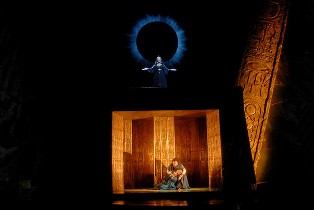
Really grand "Aida"

Now that's grand opera.
Even without the elephant.
Verdi's "Aida" marched onstage Wednesday night at Music Hall with all the creatures in place that make opera the ultimate theatrical experience.
There was great singing, dancing, visual spectacle, a gripping story and the gloriously brassy Cincinnati Symphony Orchestra
(complete with cimbasso, a contrabass valve trombone) led with great skill by Richard Buckley. With three intermissions, it ran three hours
and 45 minutes, but there were few defectors and most people remained glued to their seats until Aida and Radames (soprano Lisa Daltirus and
tenor Richard Margison) breathed their last, sealed in a tomb.
The story is both sweeping and intimate. Egyptian general Radames, whohas fallen in love with Aida, an Ethiopian slave, is commissioned to
fight her countrymen. He returns victorious, but the Pharaoh gives himthe hand of his daughter Amneris (mezzo-soprano Irina Mishura) instead
of Aida. On the eve of the wedding, Aida's father, the Ethiopian King Amonasro, (Gordon Hawkins), persuades her to obtain information from
Radames about the movements of the Egyptian army. Amneris has Radames arrested, but offers to free him if he will give up Aida. He refuses
and is condemned to death. Aida steals into the tomb to share his fate.
The action transpired on a huge, eye-popping set designed by Allen Charles Klein for the Florida Grand Opera production that opened Miami's new
Carnival Center for the Performing Arts last fall. You know it's a winner when the audience applauds the set and sure enough, they did as the curtain rose on the royal palace in Thebes where Radames awaits news about who has been named to lead the Egyptian army against the Ethiopians.
The design is Ancient Egyptian mod, with very effective use of symbols like the sun disk (Ra, the sun god), the cross-like ankh and the eye of Horus.
Reflecting the opera's tragic events, Ra was replaced in the final scene by a solar eclipse.
The scene in the temple of Ptah features an enormous statue of the god with attendants on each side and a brazier filled with fire. Dancer Susan Hairston of Cincinnati Ballet danced in a nude body stocking on a platform to one side.
The triumphal scene transpired between a pair of tall platforms backed by a brilliant azure sky. The Nile scene featured over-sized foliage, steps leading
into the temple of Isis and the bow of a stylized ship. The tomb in the last act was surmounted by a large ankh at each end and had an enormous slab that
could be raised to afford a view of the inside.
Costumes and makeup were equally striking with much use of gold, gray and white face and body paint. The white-shrouded priests in the judgment
scene had black, hollowed-out looking rings around their eyes. Amneris was a black gown in the tomb scene, where she looked like a moth folding her wings
as she sang "Pace" ("Peace") to the dying Radames.
Vocally, there were many thrilling moments. Daltirus is a great Aida, able to lightly graze high notes and pump power and substance into low ones. She is
also a keen actress and conveyed Aida's anguish ("O patria mia") poignantly.
Margison, a powerful Radames, met the challenge of singing his showpiece "Celeste Aida" just moments into the opera and his duets with Daltirus soared.
Russian born Mishura displayed a versatile, sumptuous voice. She and Daltirus were like sparks hitting an iron in their act II confrontation in Amneris'
chambers.
Hawkins' warm-edged bass lent extra humanity to Amonasro, while bass Burak Bilgili was commanding as the high priest Ramfis. Soprano Carol
Dusdieker as the high priestess unfortunately veered sharp in the temple scene.
The Chorus performed with distinction throughout, whether demanding war, celebrating victory or offering soft invocations to Ptah. Dancers from Cincinnati Ballet (nimble youngsters in Amneris' chamber!) were a vital, vibrant component of the triumphal scene. Bliss Hebert's stage direction was
remarkably smooth throughout.
If you missed the "zoo parade," a tradition begun when the opera performed at Cincinnati Zoo, Erik the Steller's Sea Eagle (8-foot wing span) made a
dignified, elegant appearance in the triumphal scene.
Repeats are 8 p.m. Friday, 3 p.m. Sunday and 8 p.m. Tuesday at Music Hall.
(first published in The Cincinnati Post July 26, 2007)